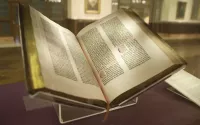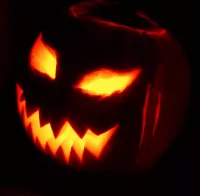Horror comics, including comic books, graphic novels, and manga, have experienced periods of both popularity and decline. The genre peaked in the US in the late 1940s but declined due to censorship concerns and the Comics Code Authority. Black-and-white horror magazines thrived in the 1960s-70s, and mainstream color comics saw a resurgence in the 1970s. Horror comics maintain a dedicated following and hold a distinct place within the broader comics industry.
1933: Rise of "Weird Menace"
The "weird menace" subgenre of horror, characterized by sadistic villains and graphic violence, gained traction in pulp magazines in 1933, influenced by Grand Guignol theater.
1935: Early Horror Elements in Superhero Comics
In 1935, National Periodicals published New Fun Comics #6, featuring the first Doctor Occult story, where he confronts a vampire. Batman also fought a vampire in Detective Comics # 31–32.
December 1940: "New Adventures of Frankenstein" Begins
Prize Comics introduced "New Adventures of Frankenstein" in Prize Comics #7 in December 1940, considered America's first ongoing horror comic book series.
1940: Early Horror Stories Emerge
Individual horror stories started appearing in comic books as early as 1940, laying the groundwork for the genre's future.
June 1943: Classic Comics Adapts "Sleepy Hollow"
Classic Comics #12, released in June 1943, featured an adaptation of Washington Irving's "The Legend of Sleepy Hollow" as a backup story.
August 1943: Classic Comics #13 Publishes "Dr. Jekyll and Mr. Hyde"
Gilberton Publications' Classic Comics #13, released in August 1943, is considered the earliest known dedicated horror comic book, adapting Robert Louis Stevenson's Strange Case of Dr Jekyll and Mr Hyde as the full-length story "Dr. Jekyll and Mr. Hyde".
August 1943: Classic Comics #13 Release
In August 1943, Gilberton Publications released Classic Comics #13, a full-length adaptation of Robert Louis Stevenson's Strange Case of Dr Jekyll and Mr Hyde, considered the first dedicated horror comic book.
1943: Suspense Comics Debut
Suspense Comics, a title with horror elements, began its run in 1943, adding to the growing popularity of the genre.
1944: Yellowjacket's "Tales of Terror"
Yellowjacket comics, debuting in 1944, featured a series of horror stories titled "Tales of Terror" within its run, showcasing the genre's reach.
April 1945: "New Adventures of Frankenstein" Ends (Initially)
The "New Adventures of Frankenstein" series concluded in Prize Comics #52 in April 1945, only to be revived later in a different format.
1945: Horror Motifs in Detective Comics
By 1945, some detective and crime comics started incorporating horror elements like spiders and eyeballs into their graphics, often adapting stories from Edgar Allan Poe or pulps.
July 1946: Strange Story and "The Man in Black"
Harvey Comics' Strange Story, released in July 1946, introduced Bob Powell's "The Man in Black," an early example of the omniscient-observer host found in horror radio dramas.
1946: Eerie #1 Hits Stands
Although cover dated January 1947, Avon's Eerie #1 was sold in late 1946.
January 1947: Eerie #1 Release
Avon Publications released Eerie #1 in January 1947, notable for being the first horror comic to feature original content.
1947: Eerie's Early Foray
Eerie's first issue, published in 1947, demonstrated an early attempt at a horror comic, though it would later relaunch in 1951.
1947: William Gaines Inherits Educational Comics
In 1947, William Gaines took over Educational Comics, setting the stage for a significant shift towards horror comics under his leadership.
March 19, 1948: "Psychopathology of Comic Books" Symposium
On March 19, 1948, a symposium titled "Psychopathology of Comic Books" raised concerns about the potential negative psychological effects of comic books on young readers.
March 25, 1948: "Horror in the Nursery" Published
Judith Crist's article "Horror in the Nursery," published in Collier's Weekly on March 25, 1948, contributed to the rising criticism against comic books, further fueling the debate on their potential harm.
March 29, 1948: Supreme Court Overturns Publication Ban
On March 29, 1948, a US Supreme Court ruling overturned a New York State law that banned publications featuring "pictures and stories of deeds of bloodshed, lust or crime," providing a temporary reprieve for comic book publishers.
May 29, 1948: "The Comics ... Very Funny!" Published
Fredric Wertham's article "The Comics ... Very Funny!" published in The Saturday Review of Literature on May 29, 1948, intensified the scrutiny on comic books, alleging their negative influence on children.
November 1948: EC's First Horror Story and More
In November 1948, EC Comics, a future giant in horror comics, published its first horror story, "Zombie Terror," in Moon Girl #5. This month also saw Trans-World Publications' one-shot Mysterious Traveler Comics #1, featuring a reprint of Edgar Allan Poe's "The Tell Tale Heart".
1948: Adventures into the Unknown: First Ongoing Horror Comic
American Comics Group, initially under the B&I Publishing imprint, launched Adventures into the Unknown in the fall of 1948, recognized as the first continuing-series horror comic.
1948: Adventures into the Unknown Premiere
American Comics Group, under the B&I Publishing imprint, launched Adventures into the Unknown, the first ongoing horror comic series, in 1948.
May 1949: Atlas Comics Enters Horror
Atlas Comics, the precursor to Marvel Comics, fully embraced the horror genre with Amazing Mysteries #32 in May 1949, after incorporating horror elements in its superhero titles during the 1940s.
August 1949: Marvel Tales Emerges
Marvel Mystery Comics transitioned into the horror series Marvel Tales with issue #93 in August 1949, signaling a shift in focus for the publisher.
October 1949: Captain America Goes Weird
The superhero anthology Captain America Comics concluded with issues #74-75 in October 1949 and February 1950, rebranding as the primarily horror-themed Captain America's Weird Tales, reflecting the growing interest in the genre.
1949: Surge in Horror Comics Titles
Between 1949 and March 1955, the comics industry experienced a surge in horror titles from various publishers, marking a period of significant growth and popularity for the genre.
1949: Horror Comics Rise in Popularity
Following the success of crime and romance comics, horror comics began experiencing a surge in popularity in 1949, attracting a wider audience.
February 1950: Captain America's Weird Tales Concludes
Captain America's Weird Tales concluded with issue #75 in February 1950.
1950: EC Comics Launches Horror Anthologies
In 1950, EC Comics introduced influential horror-comics anthologies, including "The Haunt of Fear," "The Vault of Horror," and "The Crypt of Terror," later renamed "Tales from the Crypt."
August 1951: Black Cat Transforms
Harvey Comics reformatted its costumed-crimefighter comic Black Cat into the horror-focused Black Cat Mystery with issue #30 in August 1951, further illustrating the genre's increasing popularity.
1951: Eerie's Revival
After a brief hiatus, Eerie was revived by Avon Publications in 1951, running for 17 issues and solidifying its place in horror comics history.
1951: DC Comics Introduces Horror Titles
In 1951, DC Comics introduced "House of Mystery," followed by "House of Secrets" in 1956, marking their entry into the horror genre, although these titles later shifted towards suspense and other genres.
March 1952: "Frankenstein" Revived
"Frankenstein" was revived as a horror series in March 1952, running until November 1954, showing the enduring appeal of the character.
1952: "Journey into Mystery" Premieres
Marvel Comics introduced "Journey into Mystery" in 1952, showcasing a blend of genres, including horror and suspense.
1953: Horror Comics Reach Peak Popularity
By 1953, horror comics had reached a peak in popularity, accounting for a significant portion of all comic books published, setting the stage for increased scrutiny and eventual censorship.
May 1954: Gaines and Kefauver Clash
In May 1954, the conflict between William Gaines and Estes Kefauver over the content of "Crime Suspenstories" issue 22 garnered significant media attention, highlighting the growing concerns about horror comics.
September 1954: Comics Code Authority Formed
In September 1954, the formation of the Comics Code Authority marked a turning point for the comic book industry, imposing strict regulations on content, particularly impacting horror comics.
November 1954: "Frankenstein" Concludes (Again)
The revived "Frankenstein" series published its final issue in November 1954, marking another chapter in horror comics.
1954: Eerie's Second Run Ends
Avon Publication's Eerie ended its second run with issue #17 in September 1954.
1954: "Seduction of the Innocent" Published
In 1954, Dr. Fredric Wertham's book "Seduction of the Innocent" made a significant impact on public opinion about comic books, claiming a direct link between horror comics and juvenile delinquency.
1954: Senate Subcommittee Hears Wertham's Testimony
In 1954, the Senate Subcommittee on Juvenile Delinquency, led by Estes Kefauver, heard compelling testimony from Dr. Wertham, who argued that comic books had a harmful influence on young minds.
1954: Comics Code Authority Established
In 1954, the horror comics industry experienced a major shift with the establishment of the Comics Code Authority, leading to self-imposed censorship.
March 1955: Decline of Horror Comics Publication
By March 1955, the horror comics publication landscape saw a decline as a direct result of the industry's self-imposed censorship through the Comics Code.
1955: Children and Young Persons (Harmful Publications) Act in Britain
In 1955, the UK introduced the Children and Young Persons (Harmful Publications) Act in response to concerns about horror comics, leading to the removal of horror reprints from newsstands.
1956: "House of Secrets" Premieres
DC Comics launched "House of Secrets" in 1956, initially exploring horror themes before transitioning to other genres.
1958: Birth of Horror Manga Magazines
The first horror manga boom, influenced by Kaiki shōsetsu zenshū and Hammer Films, led to the creation of "Kaidan," the first magazine dedicated to horror and mystery, in 1958.
1960: Appearance of Supernatural Cats in Manga
The theme of cats with supernatural powers, specifically bakeneko, emerged in horror manga in 1960 with the publication of "Kin'iro hitomi."
1961: Dell Comics Publishes "Twilight Zone" Comic
In 1961, Dell Comics obtained the license for the popular TV series "Twilight Zone" and began publishing a comic book adaptation, capitalizing on the show's suspense and supernatural themes.
1962: Dell and Gold Key Publish Horror Titles
Dell Comics published a short-lived Dracula title in 1962, while Gold Key Comics acquired the "Twilight Zone" license from Dell in the same year, indicating a continued interest in horror-related content.
1963: Dell Comics Launches "Ghost Stories"
In 1963, Dell Comics introduced the horror comic book series "Ghost Stories," further exploring the genre despite the restrictions imposed by the Comics Code.
1964: "House of Mystery" Features Superheroes
From 1964 to 1968, DC Comics' "House of Mystery" underwent a significant shift, featuring superhero characters like J'onn J'onzz, the Manhunter from Mars, and later, Dial H for Hero.
1964: Warren Publishing Debuts "Creepy"
In 1964, Warren Publishing, under the guidance of Archie Goodwin, introduced "Creepy," a black-and-white horror anthology comic magazine. This marked the start of Warren's significant foray into horror comics.
1964: Rise of Erotic-Horror Comics in Italy
The erotic-horror comic genre emerged in Italy in 1964 with the debut of "Satanik," sparking a wave of similar titles like "Jacula," "Sukia," and "Zora," often featuring female characters and published as "fumetti sexy."
1965: Gold Key Publishes Horror Comics
In 1965, Gold Key Comics released three horror-themed comic books. Two of them, "The Addams Family" and "The Munsters," were based on popular horror-comedy television shows. The third, titled "Ripley's Believe it or Not!," explored various supernatural phenomena and strange occurrences.
1966: "House of Secrets" and "Journey into Mystery" End
Both DC Comics' "House of Secrets" and Marvel Comics' "Journey into Mystery" concluded in 1966, reflecting the changing landscape of the comic book industry.
1966: "Eerie" Anthology Joins Warren's Lineup
Expanding its horror offerings, Warren Publishing launched "Eerie," a new black-and-white horror anthology comic, in 1966.
1966: Eerie Publications and Stanley Publications Join the Horror Fray
In 1966, Eerie Publications dove into the world of black-and-white horror magazines. They offered a mix of original content and reprints from pre-Comics Code horror comics. Their flagship title, "Weird," became a prominent player in the horror genre. During the same year, Stanley Publications also entered the scene, publishing their own line of black-and-white horror magazines, featuring titles like "Shock" and "Chilling Tales of Horror."
August 1967: End of an Era: Adventures into the Unknown Concludes
After a long run, Adventures into the Unknown published its final issue in August 1967, marking the end of a pioneering horror comic series.
1967: ACG Ceases Operations
ACG, a prominent publisher of horror and other comic book genres, ceased operations in 1967.
August 1968: DC Comics Revives Horror in "House of Mystery"
In August 1968, DC Comics brought a renewed focus on horror with the return of "House of Mystery" to its original horror theme starting with issue #175. This shift marked a resurgence of horror elements in DC's comics.
1968: Rise of Kyofu and Kowai Manga
A new style of horror manga, known as kyofu and kowai, emerged in 1968, targeting a younger audience with titles like "Hakaba Kitarō."
1968: End of "Kaidan" Magazine
After 101 issues, "Kaidan" magazine, dedicated to horror and mystery, ceased publication in 1968.
1968: Eerie Publications Expands with "Tales of Voodoo"
Eerie Publications added to their growing list of horror titles with the debut of "Tales of Voodoo" in 1968.
1968: Continued Exploration of Cats and Transformation
Horror manga continued to explore themes of cats and transformation in 1968 with titles like "Neko to watashi to haha to buta."
1968: "Strange Tales" Concludes
Marvel Comics' "Strange Tales" ended its run in 1968, having explored various genres, including horror, during its publication history.
1969: Eerie Publications Launches Multiple Horror Titles
In 1969, Eerie Publications significantly expanded its horror lineup with the introduction of three new magazines: "Horror Tales," "Tales from the Tomb," and "Terror Tales." These titles further solidified Eerie Publication's place within the horror genre.
1969: Underground Horror Comic "Bogeyman" Debuts
The underground comic scene embraced horror in 1969 with the release of "Bogeyman," reflecting the growing interest in the genre among independent creators.
1970: Underground Cartoonists Explore Horror
The early 1970s saw a surge in underground cartoonists, many influenced by EC Comics, creating their own horror comics. Titles like "Skull," "Fantagor," and "Insect Fear" pushed boundaries and offered alternative takes on the horror genre.
1971: "Up From The Deep" Emerges in Underground Comics
Adding to the expanding world of underground horror, "Up From The Deep" debuted in 1971.
1971: Marvel Embraces Horror with "Morbius" and "Tomb of Dracula"
Following the relaxation of the Comics Code Authority's regulations in 1971, Marvel Comics fully embraced the horror genre. They introduced "Morbius, the Living Vampire," a scientifically-created vampire-like character, followed by the debut of "Dracula" in "Tomb of Dracula." This marked the beginning of a wave of horror titles from Marvel, including "Supernatural Thrillers," "Werewolf by Night," "Ghost Rider," and "Son of Satan."
1971: Stanley Publications Exits the Horror Magazine Scene
In 1971, Stanley Publications ceased publishing their line of black-and-white horror magazines, ending their five-year venture into the genre.
1971: Comics Code Authority Relaxes Horror Restrictions
In a significant development for the horror comics genre, the Comics Code Authority (CCA) relaxed some of its long-standing rules regarding horror content in 1971. This change paved the way for a resurgence of horror comics and allowed publishers to explore darker themes and imagery.
1972: Publication of "Devilman"
"Devilman," a significant horror manga series, was published in mainstream magazines in 1972.
1972: Underground Horror Comics Continue to Emerge
The wave of underground horror comics continued in 1972 with titles like "Death Rattle," "Gory Stories," and "Deviant Slice" hitting the scene, further diversifying the horror comic book landscape.
1973: Underground Horror Comic "Two-Fisted Zombies" Released
"Two-Fisted Zombies," an underground horror comic, was released in 1973.
1974: Eerie Publication's "Tales of Voodoo" Ends
After a run of six years, Eerie Publication's horror magazine "Tales of Voodoo" ceased publication in 1974.
1975: Eerie Publication's "Tales from the Tomb" Ends its Run
Eerie Publication's horror title, "Tales from the Tomb," concluded in 1975, marking the end of its six-year run.
1979: Eerie Publication's "Horror Tales" and "Terror Tales" Come to an End
1979 saw the conclusion of two more of Eerie Publication's horror titles, "Horror Tales" and "Terror Tales." Both magazines had been running for a decade.
1981: Eerie Publication's "Weird" Concludes
Eerie Publication's flagship horror magazine, "Weird," ended its run in 1981, having been a notable presence in the genre since 1966.
1982: Publication of "Bakeneko shojo"
"Bakeneko shojo," a horror manga focusing on the bakeneko theme, was published in 1982.
1982: DC Comics Revives "Swamp Thing"
Capitalizing on the release of Wes Craven's film adaptation, DC Comics brought back the horror series "Swamp Thing" in 1982.
1982: Pacific Comics Pushes Boundaries with "Twisted Tales" and "Alien Worlds"
In 1982, Pacific Comics published "Twisted Tales" and "Alien Worlds." These series, while inspired by EC Comics, were notable for their graphic content and mature themes, foreshadowing the future direction of horror comics.
1983: End of an Era: Warren Publishing's "Creepy" and "Eerie" Cease Publication
Both "Creepy" and "Eerie," two pioneering horror comics anthologies from Warren Publishing, came to an end in 1983, marking a turning point in the history of horror comics.
1984: Alan Moore Takes Over "Swamp Thing"
In 1984, British writer Alan Moore took the helm as writer for "Swamp Thing." This marked a significant turning point for the series, as Moore, with the support of editor Karen Berger, would go on to redefine the character and the book's direction.
1985: End of Scream! Comic
British horror comic Scream!, aimed at older boys, ceased publication in 1985, potentially due to content concerns or financial difficulties.
1985: "Death Rattle" Revived by Kitchen Sink
In 1985, Kitchen Sink revived the horror comic "Death Rattle," originally published in 1972, indicating a resurgence of interest in horror and a trend toward independent publishing within the genre.
1986: Launch of "Halloween" Magazine
The horror manga magazine "Halloween" began its publication run in 1986.
1987: "Elvira's House of Mystery" Marks the End of an Era
DC Comics published "Elvira's House of Mystery," a horror-themed anthology, for a brief period around 1987. This marked the final attempt to produce a traditional, code-approved horror anthology title. The series' short run and the disappearance of other horror titles from major publishers like Warren signaled a shift toward new formats and independent publishing within the horror comics genre.
1987: "House of Mystery" Concludes
DC Comics' "House of Mystery" concluded its run in 1987, having transitioned from horror to other genres over the years.
1987: Debut of "Suspiria" Magazine
The horror manga magazine "Suspiria" launched in 1987.
1988: "Hellblazer" Spins Off from "Swamp Thing"
As a testament to the success of Alan Moore's run on "Swamp Thing," DC Comics launched the spin-off series "Hellblazer" in 1988. The new series featured occult detective John Constantine, a character who had first appeared in the pages of "Swamp Thing."
1988: Stephen R. Bissette's "Taboo" Anthology Debuts
Stephen R. Bissette, a prominent figure in horror comics, launched the critically acclaimed horror anthology "Taboo" in 1988. The anthology showcased a range of horror stories and art, contributing to the evolving landscape of horror comics.
1993: DC Comics Launches Vertigo Imprint
In 1993, DC Comics launched Vertigo, an imprint dedicated to mature readers. Vertigo became the home for a number of established horror titles like "Hellblazer" and "Swamp Thing," and also published new series like Neil Gaiman's "Sandman," which blended horror with fantasy elements.
1995: End of "Halloween" Magazine
After nine years of publication, "Halloween" magazine ceased in 1995.
1995: Stephen R. Bissette's "Taboo" Anthology Concludes
Stephen R. Bissette's influential horror anthology, "Taboo," came to an end in 1995 after a successful seven-year run.
1999: Vertigo Debuts Horror Anthology "Flinch"
Vertigo introduced its own horror anthology series, "Flinch," in 1999.
2000: Release of "Uzumaki" Film Adaptation
"Uzumaki," a horror manga, was adapted into a film in 2000.
2001: Marvel Introduces MAX Imprint
In 2001, Marvel launched its adult imprint, MAX, to explore more mature themes and violence in its horror comics, including reinterpretations of characters like Devil-Slayer, Werewolf by Night, Man-Thing, Zombie, and Hellstorm: Son of Satan.
2001: Vertigo Concludes Horror Anthology "Flinch"
Vertigo's horror anthology, "Flinch," concluded in 2001.
2004: Vertigo Explores Vampire Lore in "Bite Club"
Continuing its exploration of horror themes, Vertigo launched the vampire series "Bite Club" in 2004.
2008: London Horror Comic Launches
The London Horror Comic debuted in 2008, becoming the first full-color UK horror comic distributed internationally through Diamond Comic Distributors.
2010: Premiere of "The Walking Dead" TV Series
Robert Kirkman's horror comic book series "The Walking Dead" premiered as an ongoing TV series on AMC in 2010.
2012: Conclusion of "Suspiria" Magazine
"Suspiria" magazine ended its publication run in 2012.
2013: The Cannibal Family Debut
The horror comic series "The Cannibal Family," created by Stefano Fantelli and Stefano Piccioni, was first published by Edizioni Inkiostro in 2013.
2014: Film Adaptation of "Z ~Zed~"
The horror manga "Z ~Zed~" was adapted into a film in 2014.
2015: Bugs Comics Launches Mostri Anthology
Bugs Comics introduced the horror anthology "Mostri" in 2015, showcasing the work of both new and established Italian artists.
2017: Splatter Anthology Reprint
A selection of stories from the Italian horror anthology "Splatter" was collected and reprinted in two volumes by Editoriale Cosmo in 2017 and 2018.
October 31, 2018: Mostri 9 Release
Bugs Comics published "Mostri 9," an issue of their horror anthology series, on October 31, 2018.
2018: Annexia Revives Classic Italian Horror Heroines
In 2018, Annexia began publishing new adventures of classic Italian horror heroines like Ulula, Jakula, Sukia, and Zora.
2018: Splatter Anthology Reprint (Volume 2)
The second volume of the reprinted "Splatter" anthology was released in 2018.
2020: Editoriale Cosmo Reprints Erotic-Horror Classics
Editoriale Cosmo started reprinting classic Italian erotic-horror stories in 2020 as part of their "Classics of Italian Erotica" series.
Mentioned in this timeline
Marvel Comics founded in as Timely Comics by Martin Goodman...

Books are a means of storing information as text or...

The domestic cat is a small domesticated carnivorous mammal and...
Italy officially the Italian Republic is located in Southern and...

Halloween is an annual celebration on October st preceding All...

Neil Gaiman is a prolific English author known for his...
Trending

Adam Thielen is a professional American football wide receiver who most recently played for the Carolina Panthers He is known...

29 days ago Jake Paul to Fight Anthony Joshua on December 19: A Sensational Boxing Match

27 days ago Maxxine Dupri, assisted by AJ Lee, dethrones Becky Lynch for Intercontinental Title on Raw!

6 months ago Stephanie Vaquer Features on WWE SmackDown Amidst Cena & Paul's Ambush.

9 months ago Michael Keaton's Batman: Catchphrase, Killer Moments, and Reboot Rescue Attempts Explored.
5 months ago TJ Watt becomes highest-paid non-QB after extension; JJ Watt reacts hilariously.
Popular

Candace Owens is an American conservative political commentator and author...

Ilhan Omar is an American politician currently serving as the...

XXXTentacion born Jahseh Dwayne Ricardo Onfroy was a controversial yet...

Frederick Christ Trump Sr - was an American real estate...

Charles James Charlie Kirk was a prominent American right-wing political...

Oprah Winfrey an American talk show host television producer actress...